Sri Lanka Heritage (11 Days)
Sri Lanka Heritage
11 Days & 10 Nights
All our tours are tailor made tour. We can customize this tour in Sri Lanka to suit your requirements. You can decide where do you want to go and how many days stay in Sri Lanka. As you wish, if you mention the names of the hotels you want to stay, we can reserve it for you.

On arrival at the Bandaranaike International Airport, you will get your first taste of warm Sri Lankan hospitality; representative from Aliyah Tours will welcome you at the airport arrival lobby.
Transfer to Katunayaka. Check-in to the hotel & relax their.
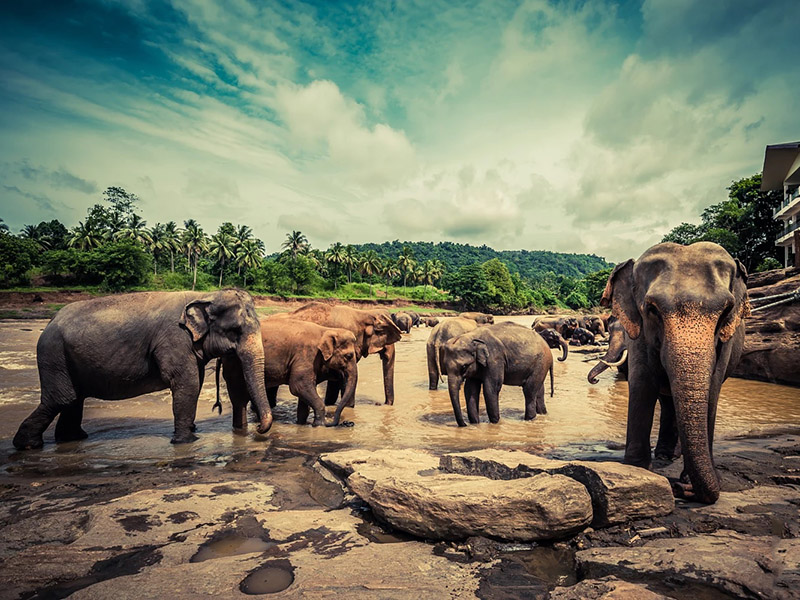
Dambulla rock temple has been built in the 1st century B.C. and it is a world heritage site. Also, it is the most impressive of Sri Lanka’s cave temples. Hewn into a 160m granite outcrop are the remarkable cave temples of Dambulla. Located at the centre of the Island and on the main route north to Anuradhapura and Polonnaruwa, the cave temples are masterpieces of Buddhist art. Each is filled with murals depicting scenes from the Buddha’s life, and gilded statues of the Buddha in various poses.In the 1st c, BC, the Dambulla caves provided refuge to a king who fled a south Indian invasion. On reclaiming his throne, the grateful king had temples constructed in the caves that had sheltered him. These were embellished by subsequent rulers, especially during the Kandyan period in the 17th and 18th centuries.
Altogether, there are five caves. A cave 2, the Maharaja Vihara is the largest and most spectacular at over 50m long, 7m high and almost 25m deep. The spiritual energy at Dambulla is palpable and the Buddhist art on display is unparalleled in Sri Lanka. An added bonus is the majestic view from the top of the rock. The complex of five caves with over 2000 sq. meters of painted walls and ceilings is the largest area of paintings found in the world. It contains over 150 images of the Buddha of which the largest is the colossal figure of the Buddha carved out of rock and spanning 14 meters.
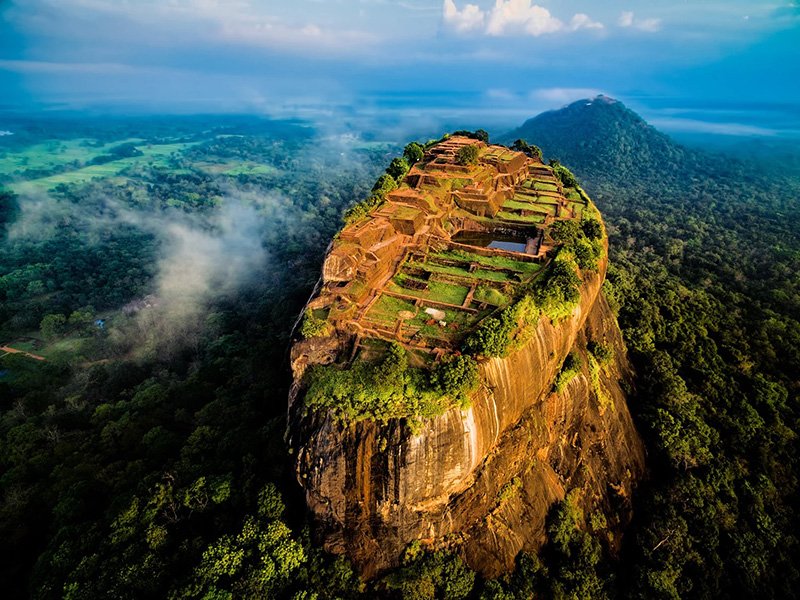
After breakfast, transfer to Dambulla & on route you will visit Pinnawala Elephant Orphanage.
Those who want to see the tamed and a semi wild elephant in close proximity the best place is the “Pinnawala Elephant Orphanage”. It is located northwest of Kegalle town along the Colombo -Kandy main road. The orphanage is in a beautiful greenish land with fruitful twenty five acre coconut land and having grasses over the underground near Maha Oya. The wide area of shallow water and the huge rocks of Maha Oya make the ideal place to these magnificent animals. Elephant Orphanage was established in 16th February 1975 by the Department of Wild Life Conservation. At the beginning of orphanage there were only five orphan baby elephants those who brought from different places of the island. From the inceptions to date, Neela, Wijaya, Kadira, Mathali and Kumari are some of babies that were brought to the facility still living in the orphanage. Since then orphan elephants brought to the orphanage from different parts of the island and brought up at the orphanage. They were fed with milk as well as array of fodder. There are 78 elephants in orphanage now and there are 69 births in the orphanage and increase the number of elephants in the herd. Pinnawala Elephant orphanage is treated as one of the largest breading center in the world. Today the heard has grown up to 69 elephants. Among the many elephants of the orphanage there are three of them which will definitely get your attention.
Part hedonistic pleasure palace, part fortress and part sacred complex, Sigirya is one of the island’s most awe-inspiring archaeological sites and a leading tourist attraction. In fact some consider it to be one of the oldest tourist attractions in the world with early visitors recording their impressions as graffiti on a wall described as the world’s first interactive book. Located north of Dambulla, the site consists of a sheer rock that rises over 200m with the ruins of a palace on the top and a vast pleasure garden complex at the foot.
For just two decades in the 5th c.AD, Sigiriya rose to prominence following a power struggle between two brothers, and an act of patricide that saw the then king walled-up alive by his son, Kasyapa. Fearful that his defeated brother would return from exile to extract vengeance, Kasyapa shifted the capital to Sigiriya.
The Megalomaniac yet spiritual Kasyapa clearly had an eye for beauty. The Pleasure gardens include a series of symmetric pools, channels and fountains that still spurt water after 1500 years. Partway up the rock are the famous Sigiriya Frescoes, featuring 21 bare-breasted damsels that may represent celestial nymphs, but were surely modeled on Kasyapa’s own consorts. Halfway you’ll encounter a pair of giant Lion’s Paws, part of the original entrance, which required visitors to pass through the open mount of the lion. The summit yields a dramatic vista of the surrounding jungle and contains the foundations of the palace complex, replete with bathing pool. But all this was to be in vain. Kasyapa descended from his palace in the clouds to face his brother astride an elephant, eventually taking his own life when facing certain defeat.

The area was designated as a national park on 12 August 1997, having been originally declared as a wildlife sanctuary in 1938. The reason for declaring the area as protected is to protect the catchment of Minneriya tank and the wildlife of the surrounding area. The tank is of historical importance, having been built by King Mahasen in third century AD. The park is a dry season feeding ground for the elephant population dwelling in forests of Matale, Polonnaruwa, and Trincomalee districts.
May to October is the best time to visit the Minneriya National Park in preparation for the famous wild elephant rally. The vegetation of the park consists of mixed evergreen tropical forests, abandoned oaks, grasslands and wetlands. Among the 24 species of mammals residing in the park are elephants, leopards, lazy bear, spotted deer, deer, wild ox, wild pig, gray leopard, purple leaf monkey, The three species of mongoose, the porcupine and the Indian pangolin. Minneriya National Park has registered more than 170 species of birds. Among the nine species of amphibians in Minneriya National Park are the endemic and threatened thin frog and the common frog. Of the 25-reptile species recorded in Park 8 are endemic, including the Red Lizard lizard. Water and soil monitors are also visible here. The Crocodile Mugger can be seen near the tank. Many freshwater fish species are found in the Minneriya reservoir.
After breakfast you will transfer to Polonnaruwa.
The next great capital which succeeded Anuradhapura and taken up for excavation and conservation by the Cultural Triangle Project is Polonnaruwa. Polonnaruwa was the medieval capital of Sri Lanka from the eleventh to the end of the first quarter of the 13th century AC. However, archaeological evidence suggests that there had been human settlements in Polonnaruwa even as far back as the second century BC. With the development of agriculture, Polonnaruva developed over the years as a vigorous agrarian economy. Both Anuradhapura and Polonnaruva came within the dry zone of the country and one of the formidable tasks the ancient rulers had to face was the conservation of the water necessary for agriculture. It is this exigency that led them to make the large and small reservoirs that lie scattered in the dry zone.
In the fourth century AC, king Mahasena, the great tank builder, built the Minneriya reservoir not far from Polonnaruva. Some other reservoirs in and around Polonnaruva were also the work of Anuradhapura kings. This provided the farmers ready access to the much needed water, which resulted in a flourishing agrarian economy that makes them self-sufficient. King Parakramabahu I combined three small tanks and built the largest reservoir called the ‘Sea of Parakrama’ of which you can have a panoramic view from the lounge of the Rest House in Polonnaruwa.
Today the ancient city of Polonnaruwa remains one of the, standing testimony to the discipline and greatness of the Kingdom’s first rulers. The ancient city of Polonnaruwa has been declared a World Heritage site by UNESCO.
Polonnaruwa is the second largest city in North Central Province, but it is known as one of the cleanest and more beautiful cities in the country. The green environment, amazing ancient constructions, Parakrama Samudra and attractive tourist hotels and hospitable people, attract tourists.

Nestled in lush green hills and built around a scenic lake, the Royal City of Kandy, at 500m above sea level, is the hub of any visit to the hill country. Kandy, a UNESCO World heritage Site, was the last bastion of resistance to colonial rule, surviving two centuries of colonial incursions by the Portuguese and the Dutch before falling to the British in 1815. Even today, Kandyans pride themselves on their distinctive architecture, music, dance and art.
The showpiece of the city is the Dalada Maligawa or Temple of the Tooth Palace, which hosts the Lord Buddha’s tooth relic, an item of veneraltion to all Buddhists, is an experience no tourist should miss. Said to have been snatched from the Lord Buddha’s funeral pyre and smuggled to Sri Lanka in the hair or a princess, the tooth relic is of great spiritual significance. Strolling around the lake or exploring the numerous temples that dot the hills nearby is a great way to get the feel of this historic city. Each Year, in August, the city holds the Esala Perahera (procession), a spectacular display of medieval Pageantry replete with caparisoned elephants, whirling fire dancers, and pulsating drummers.
Visit Bazaar area, Arts & crafts centre, a Gem museum and a lapidary etc.
In the evening visit Temple of the Tooth Relic. Late evening witness the Cultural Show, experiencing the pulsating drum rhythms and colorful traditional dances at a cultural show is another must.
After breakfast, we proceed to Mathale.
Visit Aluwiharaya. Founded during the reign of King Devanampiyatissa in the 3rd century BC, this temple has a very significant value on the preserving of Buddhism in the country. This is where the Thripitaka was made a written script.
Visit a spice garden in Matale to see different spices for which Sri Lanka is famous for. Clients will be able to see different spices and how some of these spices are grown and processed. Witness Cookery demonstrations as well.


In the evening you will visit Bazaar area, Arts & crafts centre, a Gem museum and a lapidary etc.
Sri Lanka is world famous for its valuable & semi-precious Gems. Specially Sri Lankan Blue Sapphire. It is very exclusive & owns a huge reputation in the world. Clients could visit a Gemological Museum, a gem cutting factory & also can witness a documentary on Gem mining & the process. Later you can shop for Gems, Jewelry & Other ornaments. Don’t forget to collect your authenticity certificate for gems.
Visit the Silk Garden. Clients will be shown the process of making silk & how the handloom sarees are been made in Sri Lanka.The ladies will be given a chance to wear a traditional Sri Lankn saree & it be an ultimate opportunity to experience the Sri Lankan dressing culture. You can shop for Silk items, sarees, sarongs, shirts & many other gorgeous materials according to your choice.
The history of the Royal Botanic Gardens dates as far back as 1371 when king Wickramabahu III ascended the throne and kept court at Peradeniya near Mahaweli River. Later, in the reign of King Kirti Sri Rajasinghe from 1747 to 1780 this was made a Royal Garden and from 1780 – 1798 King Rajadhi Rajasinghe resided therein, where a temporary residence was erected for him. This was a pleasure garden of a Kandyan King of the 16th Century and later made in to a Botanical Garden during the British regime.
The most amazing of the Garden have, Flower Garden, Palm Avenues, Plant House and Cacti, Bamboo Collection, Orchid House and Gardens, Fernery, Great Lawn, The lake, Spice Garden and Flowering Trees and the Arboretum.
The most spectacular of the Gardens are the flowering trees which come into bloom at various times with peak blooming during the first half of the year. Amherstia nobilis popularly known as the Pride of Burma is the finest and a row of this is found planted near the main entrance. An extensive Arboretum of 20 ha in extent contains approximately 8000 trees. Some of these trees are magnificent specimens which are over 100 years old.
Wood carving is a traditional industry in Sri Lanka. Believed to be emerged in the ancient temples, the traditions & the techniques were passed from one generation to another. Today some of the wonderful craftsmen who belonged to such generations are still engaged in the field. They create wood carvings, statues, furniture, habitual masks, sculptures, handy craft, and paintings and to a variety of other products of same nature. A visit to a wood carving centre involves.

Among the most iconic vistas of hill country are the rolling tea estates that carpet vast swathes of estates that carpet vast swathes of terrain in an emerald sea. Women draped in colorful saris resemble butterflies as they work their way deftly along the tea bushes, picking just two leaves and a bud from each branch and tossing them into the baskets slung on their backs. Introduced to the island in the late 19th century by the British, tea remains of vital importance to the economy.
Some of the finest teas in the world are produced in the hill country and a visit a Tea Factory during a trip to plucked tea is dried, crushed fermented and fired using machinery that has remained largely unchanged since Victorian times. Sri Lanka is world famous for Ceylon Tea. Clients will be shown a tea plantation & a factory. You will be able to witness the processing of Tea and also taste a cup of nice & hot Ceylon Tea. You can buy various different Tea products from the Tea shop.
After breakfast at Hotel transfer to Nuwara Eliya. On route visit a Tea Factory.
Nuwara Eliya is located at the heart of the hill country 6182 feet above from the sea level. At the heart of the southern hill county is Nuwara-Eliya, Sri lanka’s highest town and a favorite hill station during British colonial times. It is still very much like an old English town with styled Bungalows and buildings. The cool calm climate, gorges rolling tea plantation which makes the best “Ceylon tea” and the breathtaking beautiful waterfalls makes Nuwara Eliya one of the most beautiful town in the world. The town is still touted as ‘Little England’, an illusion maintained by the presence of the finest 18 whole golf courses in South Asia, a racecourse, the Victoria Park and excellent trout fishing in nearby lakes and rivers. The temperature can drop to close to freezing at nights and it is common to se smoke rising from the chimneys of many Tudor-style manors. Adding to the town’s atmosphere is the spectacle of its townsfolk wrapped up in winter jackets and woolly hats, carting great bundles of turnips, leeks, marrows and cabbages to and from the markets. Nuwara Eliya is a great base to explore the surrounding countryside and there are many walks on offer, including hiking around the lower slopes of the thickly forested Mount Pidurutalaga, at 2,555m the island’s highest peak.
You can visit the Golf Club, Strawberry Farms. You can take a nice evening walk around the Gregory Lake. We can arrange horse ride, boat ride and Cycling.

Soaring above the surrounding hills in the southwest of the hill county is Adam’s Peak. It is Sri Lanka’s fourth highest mountain at 2,243m. It is one of the island’s most important pilgrimage sites and is situated in the Ratnapura district. The conical shaped mountain is worth the climb for the views and spiritual experience regardless of your belief.
Adams Peak is known locally as Sri Pada (Sacred Footprint) due to the curious footprint-shaped indentation at its summit; the mountain is considered sacred to adherents of all of Sri Lanka’s main faiths – Buddhists, Hindus, Muslims and Christians and attracts many pilgrims between December and May each year. The ascent requires stamina rather than mountaineering skills and consists of over 48000 steps to the summit.
After breakfast at Hotel transfer to Adams Peak. On route Visit the Famous Ramboda Falls.
Sri Lanka is blessed with over one hundred waterfalls. Ramboda Ella is the 11th highest waterfall in Sri Lanka and 729th highest waterfall in the world. The fall is height about 109m and height from Sea Level: 945m.This gigantic water fall consists of three sections.
This unique and beautiful sight can be seen at the Pussellawa area of Nuwara Eliya, at the Ramboda Pass. The Ramboda Falls or Ramboda Ella or Puna Ella as these falls are called is created from Puna Oya, a branch of Kothmale Oya. It makes a twin with Dunsinane Falls which is created by Pundalu Oya, also a branch of Kothmale River, and combines at the base to form a Y shape.
During normal periods of the year Dunsinane Falls which falls on the right receives more volume of water than Ramboda falls. However during periods of drought the role is reversed as Dunsinane Falls, whose branch passes through farming lands before falling, has less water coming through compared to Ramboda Falls whose branch passes through a forest reserve. In this case, instead of Ramboda Falls having more water it is more due to Dunsinane receiving less water while Ramboda remains the same.
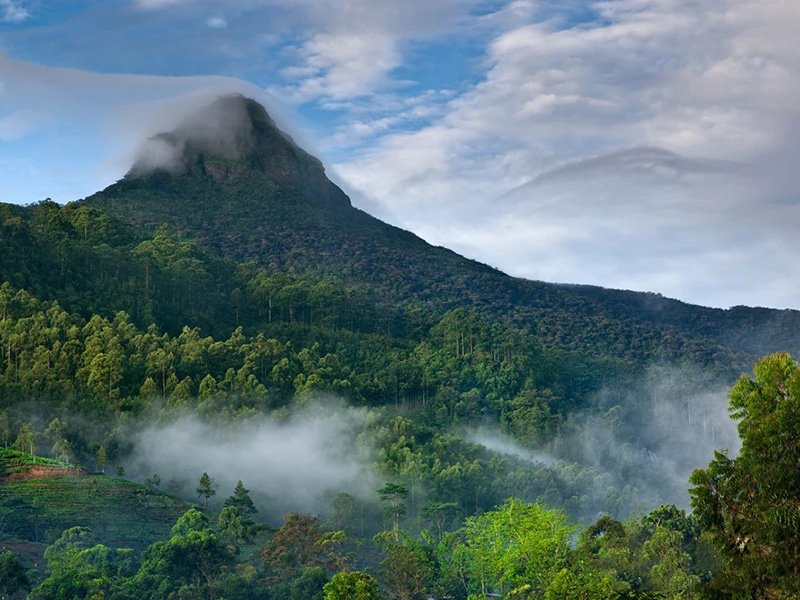
The best time to make the ascent is during the night, when the twinkling lights of the illuminated pathway appear to rise like a stairway to heaven. Tea stalls line the path and the distant tolling of the bell at the summit provides encouragement to weary climbers. Dawn at the summit is an intensely spiritual experience. Pilgrims whisper reverently to each other as the sun rises and casts a perfect triangular shadow on the clouds below, one of the island’s more unusual natural phenomena.

Climb down from Adams peak and rest at hotel.
There after transfer to Ella.
Relax at hotel.
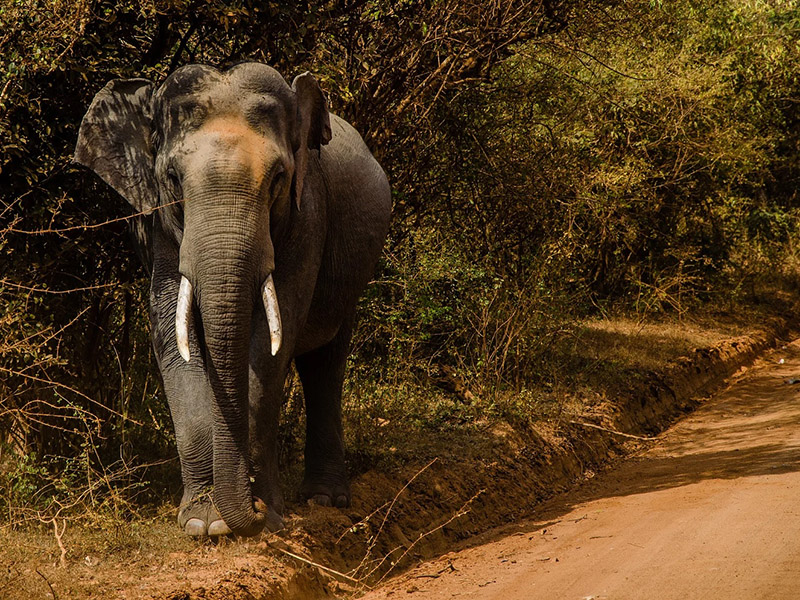
The 25m-high Ravana Falls cascades from an oval-shaped concave rock outcrop. Kirinidi Oya is the water course for this beautiful cascading waterfall. It currently ranks as one of the widest falls in the country. This waterfall measures approximately 25 m (82 ft) in high and cascade from an oval-shaped concave rock outcrop. During the dry season water level reduces drastically and Ravana falls becomes very skinny, but again becomes majestic during the upstream rainy seasons. In the dry season, the flow of water is markedly reduced, whereas rain turns the fall into what is said to resemble an area flower with withering petals. But this is not the case in the wet season, where the flow of water reduces dramatically.
The falls have been named after the legendary character Ravana, which is connected to the famous Indian epic, the Ramayana. According to story, it is said that Ravana (who was the king of Sri Lanka at the time) had kidnapped princess Sita, and had hidden her in the caves behind this waterfall, now simply known as the Ravana Ella Cave. At the time, the cave was surrounded with thick forests in the midst of wilderness. It is also believed that Rama’s queen bathed in a pool that accumulated the water falling from this waterfall. Locals who are traveling to upcountry used to stop by the Ella and get shower at here, so you can stay, relax and refresh and continue your journey.
After breakfast you transfer to Yala. On route we will stop at the Rawana Water Falls.
Then transfer to Thissa for safari at Yala national park. Check-in to the hotel and relax.
In the evening you will leave for the Wild Life safari at Yala National Park.
Declared on 1st March1938, Ruhunu National Park better known as Yala National Park is one of the most popular national parks in Sri Lanka and is well known for its rich ecological and archaeological heritage. The park is divided into five blocks and tourism is allowed only in block I. Block I is also famous for its wide range of wildlife, including the highest density of leopards in the country. It is situated in the southeast region of the country, and lies in Southern Province and Uva Province. The park covers 979 square kilometers. Yala was designated as a wildlife sanctuary in 1900, and along with Wilpattu was one of the first two national parks in Sri Lanka, has been designated in 1938.
Located in the dry zone, Yala National Park has a distinct wet and dry season. Inter-monsoon rains occurring between march-April are followed by a drought extending from May-September, followed by the northeast monsoon in September-December. The onset of the monsoon brings about a lushness which decorates it with a myriad of striking wildflowers adding scenic value to the landscape.
Yala hosts a variety of ecosystems ranging from moist monsoon forests to freshwater and marine wetlands. Yala National Park is popular among local and foreign visitors for its mega fauna – Elephant, Sloth Bear, Leopard and Wild buffalo and Wild boar. However, many smaller species inhabit the diverse habitats in the park. Although endemicity is low in comparison to wet zone forests, a large number of dry zone faunal species are found in the Yala National Park. Mammals are the biggest attraction so in addition to Elephant, Leopard and Sloth bear, keep an eye out for species such as Toque macaques, Grey langur, Ruddy mongoose, Grey mongoose, Stripe necked mongoose, wild boar, Spotted deer, Sambur, Black backed jackal and Black naped hare. The number of mammals that has been recorded from the park is 44.

The Portuguese established the first fort in Galle. This was captured by the Dutch in 1640, after which the fortifications were expanded and the grid street system established. Further extensions were made during the British period. The passenger port gained importance, but with the construction of a breakwater at Colombo, Galle slipped into maritime decline. Stroll along the massive ramparts at dusk. Experience the tranquil ambience of a bygone era yet see life as it proceeds: children flying kites, games of softball cricket, and couples canoodling behind the privacy of umbrellas. They all seem to enhance the magic of the fort.
After breakfast you transfer to Galle.
Galle, the capital of the Southern Province is a city with a colorful history. The headland of Galle before its fortifications were constructed would have been a romantic picturesque landscape overlooking Rumassala Mountain with a natural circular bay lying on the south coast of Sri Lanka. The history of Gale goes back to the days of the Ramayana with local tradition which moves from the Ramayana to the chronicle Mahawamsa in which no mention is made of Galle until the reign of King Parakramabahu the Great (1153-1186).
The main source of economy for the locals of the Galle region is the cultivation of cinnamon, tea and coconuts as well as fishing and tourist industry.
In the evening you can visit Dutch Fort at Galle. The 16th c. Dutch Fort at Galle, close to the island’s southern most point has the distinction of being the best-preserved sea fort in South Asia. Enter through the imposing stone bastions that encircle the sea-facing promontory and step back in time. Inside the Fort you will find that it exudes old-world charm. The narrow streets are dotted with Dutch colonial villas and there’s a welcome absence of vehicular traffic. There are several museums and antique shops that display curiosities from the island’s colonial era. Of the many colonial buildings, perhaps the most absorbing is the Dutch Reformed Church, containing ornately carved memorials to the city’s Dutch settlers. The Fort also hosts some of the island’s most exclusive boutique-style accommodation in former villas restored to their colonial glory.
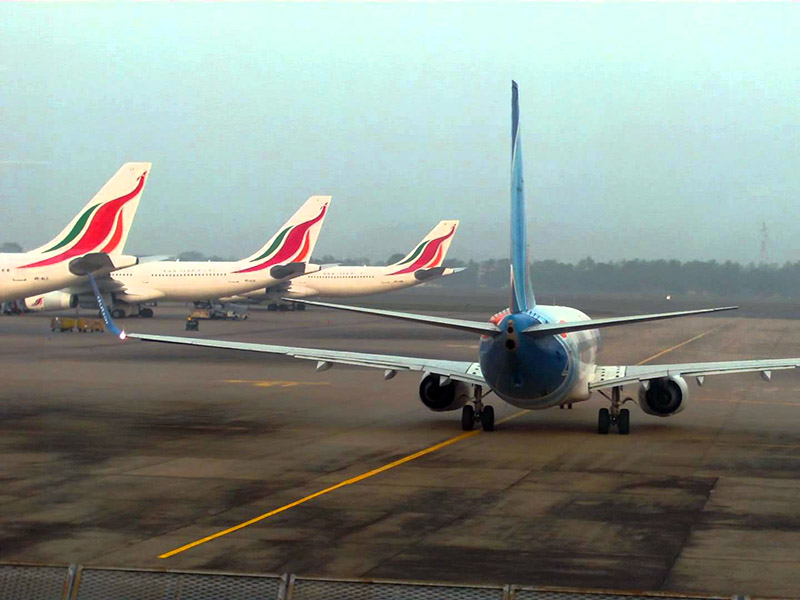
After breakfast you transfer to Airport.
On route we will stop for optional excursion in the Area
Hikkaduwa – Glass Bottom Boat Ride,
Unawatuna Beach – Underwater Diving / Snorkeling / Scuba
Meetiyagoda – Moonstone Mine
Kosgoda – Turtle Hatchery (Sea Turtle safari)
Bentota – Madu River Boart Ride
Ayurvedic Spa
Welcome the guests at the Airport by a Representative of Aliyah Tours
All Local Transfers and Sightseeing by an air-conditioned vehicle throughout the tour
Entrance Fees for Sights Visited
Visit according to the program
One litter water bottle per day
Highway Tolls
All Local Taxes
Air tickets and insurance
Immunizations / Medical
Meals and accommodation
Video camera permits
Vehicle use for night life activities
Porter rage & Tips
Cost of beverage throughout the tour
Expenses of a personal nature
Any other services not specified above
Client should pay 50% of tour amount at the arrival and the rest can be paid during the tour or at the Airport where you’re ready for the departure.
You should provide accommodation and meals for the driver.
Cancellations within 01 to 06 days of the arrival date – 100% of the value of the booking
Cancellations within 07 to 13 days of the arrival date – 50% of the value of the booking
Cancellations within 14 to 28 days of the arrival date – 25% of the value of the booking
Cancellations beyond 30 days of the arrival date – not charge

